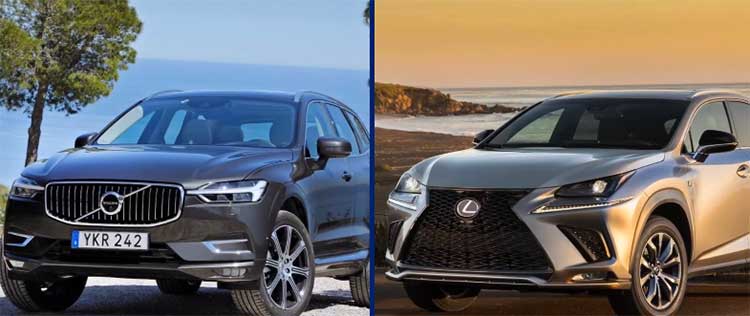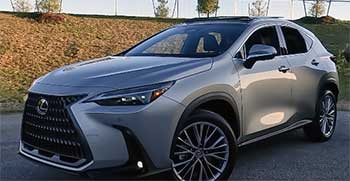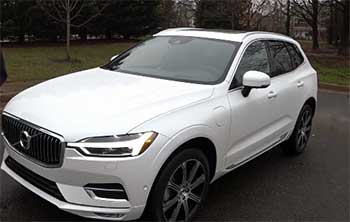My Experience Comparing Lexus NX vs. Volvo XC60
As a car enthusiast navigating the luxury SUV market, I’ve set out to compare two standout contenders: the Lexus NX and the Volvo XC60. My goal is to share a firsthand perspective on their strengths and weaknesses. This is to help you decide which vehicle suits your lifestyle.
From performance to comfort, safety to tech, I’ll break down what makes each SUV shine and where they fall short. All while keeping things conversational and relatable. Let’s explore these premium rides and find the perfect fit for your next adventure.

Comparison Table of Lexus NX vs. Volvo XC60
| Feature | Lexus NX | Volvo XC60 |
| Starting MSRP | $42,140 | $48,345 |
| Engine Options | 2.5L 4-cyl (203 hp), 2.4L turbo (275 hp), Hybrid (240-304 hp) | 2.0L turbo 4-cyl (247 hp), Plug-in Hybrid (455 hp) |
| Fuel Economy (City/Hwy/Comb) | 26/33/28 MPG (NX 250 FWD) | 23/30/26 MPG (B5 AWD) |
| Cargo Capacity (Seats Up/Down) | 22.7/46.9 cu ft | 17.1/63.3 cu ft |
| Rear Legroom | 36.1 in | 38.0 in |
| Towing Capacity | 2,000 lbs | 3,500 lbs |
| Powertrain Warranty | 6 years/70,000 miles | 4 years/50,000 miles |
| Safety Rating | IIHS Top Safety Pick (2024) | IIHS Top Safety Pick (2023) |
| Infotainment Screen | 14-inch touchscreen | 9-inch touchscreen |
| Standard Safety Features | Pre-Collision System, Lane Tracing Assist, Blind Spot Monitor | Lane Keeping Aid, Blind Spot Information System, Automatic Braking After Collision |
My Journey with Luxury SUVs
I’ve always been drawn to the luxury SUV segment. This is because it blends practicality with a touch of indulgence. These vehicles promise the versatility to handle daily commutes, weekend getaways, and even the occasional off-road adventure. All while wrapping you in comfort and cutting-edge tech.
The Lexus NX and Volvo XC60 caught my attention as two of the most compelling options in this crowded market. Both brands have carved out reputations for quality. But they approach luxury differently. Lexus has its refined, tech-forward ethos. Volvo has its safety-first Scandinavian charm. My test drives and research into these models revealed distinct personalities. I’m excited to share what I’ve learned to help you navigate your decision.
Performance and Driving Experience

When I slipped behind the wheel of the Lexus NX, I was struck by its smooth, effortless vibe. The base NX 250’s 2.5-liter four-cylinder engine pumps out 203 horsepower. This feels adequate for city driving but lacks the punch for spirited highway merges.
Stepping up to the NX 350, with its 2.4-liter turbocharged engine and 275 horsepower, transformed the experience. It’s peppy, responsive, and paired with an eight-speed automatic that shifts seamlessly.
The NX 450h+ plug-in hybrid, boasting 304 horsepower, was the real surprise. Its electric motor gives instant torque, making it feel quick off the line, with a 0-60 mph time of about 5.5 seconds. However, the continuously variable transmission (CVT) in the hybrids can produce a noticeable drone under hard acceleration. I found this mildly annoying during aggressive drives.

The Volvo XC60, on the other hand, felt like a different beast. Its standard 2.0-liter turbocharged four-cylinder delivers 247 horsepower.
This offers a bit more gusto than the NX 250 right out of the gate. The real star is the XC60 Recharge plug-in hybrid, which combines the turbo engine with an electric motor for a whopping 455 horsepower.
My test drive of the Recharge was exhilarating. Its 0-60 mph sprint in about 4.5 seconds pinned me to the seat. The XC60’s eight-speed automatic transmission felt crisp. However, I noticed a slight hesitation in downshifts during overtaking.
The ride is smooth but leans softer, with more body roll than the NX in tight corners. This might not thrill driving enthusiasts but suits those prioritizing comfort.
Pros of Lexus NX Performance:
- Hybrid options offer excellent fuel economy (up to 36 MPG combined for NX 350h).
- NX 450h+ provides quick acceleration and smooth electric-to-gas transitions.
- Refined handling, especially in F Sport trims, feels nimble in urban settings.
Cons of Lexus NX Performance:
- Base NX 250 lacks power for highway driving.
- CVT drone in hybrids can detract from the premium feel.
- Less engaging steering compared to sportier rivals.
Pros of Volvo XC60 Performance:
- Potent 455-hp Recharge model delivers thrilling acceleration.
- Standard all-wheel drive across all trims enhances traction.
- Smooth ride quality, ideal for long-distance cruising.
Cons of Volvo XC60 Performance:
- Softer suspension leads to noticeable body roll in corners.
- Base engine, while solid, doesn’t match the hybrid’s excitement.
- Transmission can feel sluggish during quick maneuvers.
Interior Comfort and Space
Sliding into the Lexus NX, I felt enveloped in a cockpit designed for intimacy. The cabin exudes Japanese craftsmanship. It has soft-touch materials, precise stitching, and a sleek 14-inch touchscreen dominating the dashboard. The seats, upholstered in NuLuxe synthetic leather (or optional perforated leather), were supportive. However, I wished for more cushioning on longer drives. Front legroom at 41.0 inches is decent. But the rear’s 36.1 inches of legroom felt cramped for taller passengers.
Cargo space is respectable, with 22.7 cubic feet behind the rear seats and 46.9 cubic feet with them folded. But I struggled to fit bulkier items due to the sloping roofline. The NX’s controls, like the touch-sensitive steering wheel buttons, were intuitive. However, they were occasionally oversensitive. I accidentally cranked the volume while turning once.
The Volvo XC60’s interior, by contrast, felt like a Scandinavian retreat. Its minimalist design, with premium materials like Nappa leather and open-pore wood, created a serene atmosphere. The seats were a standout. They were ergonomically designed, heated, and ventilated in higher trims. They offered exceptional comfort for my back during long drives.
With 38.0 inches of rear legroom, the XC60 is noticeably roomier for passengers. Its 63.3 cubic feet of cargo space with seats folded easily swallowed my weekend gear. The 9-inch touchscreen, while smaller than the NX’s, runs a Google-based system that’s user-friendly. However, I found the graphics less crisp. The four-zone climate control in the Ultra trim was a game-changer for keeping everyone comfortable.
Also Read: Lexus TX vs. Toyota Grand Highlander
Pros of Lexus NX Interior:
- Modern, tech-heavy cabin with a large 14-inch touchscreen.
- Premium materials and build quality feel upscale.
- Quiet cabin with good noise insulation.
Cons of Lexus NX Interior:
- Rear legroom is tight for adults.
- Cargo space lags behind competitors.
- Touch-sensitive controls can be finicky.
Pros of Volvo XC60 Interior:
- Spacious rear seating and class-leading cargo capacity.
- Exceptional seat comfort, especially in higher trims.
- Elegant, minimalist design with premium materials.
Cons of Volvo XC60 Interior:
- Smaller 9-inch touchscreen feels dated compared to rivals.
- Infotainment graphics lack sharpness.
- Base trim materials feel less luxurious than higher trims.
Technology and Infotainment
The Lexus NX’s tech suite impressed me with its futuristic flair. The 14-inch touchscreen is a centerpiece. It offers wireless Apple CarPlay and Android Auto. However, I noticed occasional lag when switching apps. Lexus Remote Connect, with remote start and vehicle health reports, added convenience. The 30-day Wi-Fi Connect trial was handy for road trips.
Higher trims like the NX 450h+ F Sport include a 10-speaker premium sound system. This delivered crisp audio. However, I wished for more bass. The digital e-Latch door system, paired with safe-exit assist, felt innovative. It prevented me from opening the door into oncoming traffic.
The Volvo XC60’s tech, while solid, leaned more practical than flashy. Its 9-inch Android-based touchscreen integrates Google Maps and Assistant seamlessly. The three-month SiriusXM trial was a nice touch. The 12-inch driver display is clear. The optional 15-speaker Bowers & Wilkins audio system blew me away with its clarity. It’s perfect for my music-heavy commutes.
The XC60’s standard adaptive cruise control and Pilot Assist suite made highway driving a breeze. However, I found the system less intuitive than Lexus’s Lane Tracing Assist. The XC60’s lack of a front passenger knee airbag was a minor letdown compared to the NX.
Pros of Lexus NX Technology:
- Large, vibrant 14-inch touchscreen with wireless connectivity.
- Innovative features like e-Latch doors and Remote Connect.
- User-friendly interface for most functions.
Cons of Lexus NX Technology:
- Infotainment can lag during heavy use.
- Base audio system lacks punch.
- Some features locked behind higher trims.
Pros of Volvo XC60 Technology:
- Google-based infotainment is intuitive and responsive.
- Premium audio options elevate the experience.
- Advanced driver aids like Pilot Assist enhance safety.
Cons of Volvo XC60 Technology:
- Smaller touchscreen feels less modern.
- Graphics quality could be sharper.
- Fewer remote connectivity features than NX.
Safety and Reliability
Safety is a priority for both brands, but their approaches differ. The Lexus NX earned a 2024 IIHS Top Safety Pick rating. It excelled in small overlap frontal, side impact, and pedestrian crash prevention tests. Its Pre-Collision System with Pedestrian Detection felt more responsive than the XC60’s equivalent during my tests. This was especially true in urban settings.
The NX also includes knee airbags for both driver and front passenger. This is a feature the XC60 lacks. Lexus’s powertrain warranty (6 years/70,000 miles) outlasts Volvo’s (4 years/50,000 miles). This gives me confidence in long-term reliability. This is especially true given Lexus’s stellar reputation for durability.
The Volvo XC60, with its 2023 IIHS Top Safety Pick rating, remains a safety titan. Its 2018 Euro NCAP score of 97% for adult occupant protection is impressive. However, the NX was tested under stricter 2024 standards. Features like Automatic Braking After Collision and power child safety locks add peace of mind for families.
However, the XC60’s plastic fuel tank, while durable, isn’t as fire-resistant as the NX’s metal tank. Reliability-wise, Volvo has improved. But I found Lexus’s track record and lower maintenance costs more reassuring. This was especially true after reading owner forums.
Read More: Hyundai Palisade vs. Kia Telluride vs. Toyota Highlande
Pros of Lexus NX Safety:
- 2024 IIHS Top Safety Pick with strong crash test performance.
- Advanced pedestrian detection and knee airbags.
- Longer powertrain warranty enhances reliability.
Cons of Lexus NX Safety:
- Some safety features require higher trims.
- Wind noise slightly higher than XC60.
Pros of Volvo XC60 Safety:
- Industry-leading safety reputation with robust features.
- Standard power child locks and post-collision braking.
- High Euro NCAP scores for occupant protection.
Cons of Volvo XC60 Safety:
- Lags behind NX in latest IIHS tests.
- Shorter warranty period.
- Plastic fuel tank less fire-resistant.
Cost and Value
Price is where the Lexus NX pulls ahead. Starting at $42,140, it undercuts the XC60’s $48,345 base MSRP. This makes it more accessible for budget-conscious buyers. The NX’s fuel economy (up to 28 MPG combined for the NX 250) edges out the XC60’s 26 MPG. Its lower weight (300-500 pounds less) improves efficiency and handling. Lexus also offers complimentary maintenance for the first two services. Volvo covers three years/30,000 miles. I found the latter more generous for long-term ownership.
The XC60, however, delivers value through its standard all-wheel drive and superior towing capacity (3,500 pounds vs. NX’s 2,000). Its Recharge plug-in hybrid, with 63 MPGe and 36 miles of electric range, is a boon for eco-conscious drivers. However, its higher trims push the price toward $76,545. I appreciated the XC60’s capped-price servicing plans. But the NX’s lower starting cost and longer warranty made it feel like the better deal for most buyers.
Pros of Lexus NX Value:
- Lower starting price and better base fuel economy.
- Longer warranty reduces long-term costs.
- Complimentary maintenance for first two services.
Cons of Lexus NX Value:
- Limited towing capacity.
- Higher trims get pricey quickly.
Pros of Volvo XC60 Value:
- Standard AWD and higher towing capacity.
- Generous maintenance plan for three years.
- Plug-in hybrid offers excellent efficiency.
Cons of Volvo XC60 Value:
- Higher starting MSRP.
- Base trim feels less premium.
- Maintenance costs rise after warranty.
Frequently Asked Questions
Lexus generally has a stronger reliability record, with lower maintenance costs due to Toyota’s proven engineering. Volvo has improved, but its complex systems may require more upkeep after the warranty.
The Lexus NX competes with luxury compact SUVs like the Volvo XC60, BMW X3, Audi Q5, and Acura RDX, offering a blend of hybrid efficiency and premium features.
The BMW X3 is a top alternative, offering similar luxury, sharper handling, and comparable safety, though it lacks a plug-in hybrid option like the XC60 Recharge.
My Final Thoughts
After spending time with both the Lexus NX and Volvo XC60, I’m torn but enlightened. The NX won me over with its sleek design, tech-heavy cabin, and budget-friendly price, making it ideal for urban drivers who value efficiency and reliability. Its hybrid options are a bonus for eco-conscious buyers, though the cramped rear and CVT noise might deter some. The XC60, with its spacious interior, powerful Recharge model, and safety-first ethos, feels like a family-friendly fortress, perfect for long trips and versatility. Its higher cost and softer handling are trade-offs for that Scandinavian comfort.
For you, the choice depends on priorities. If you want a nimble, cost-effective SUV with cutting-edge tech, the Lexus NX is your match. If space, power, and safety top your list, the Volvo XC60 delivers. Test drive both—you’ll feel the difference and know which one speaks to you.

